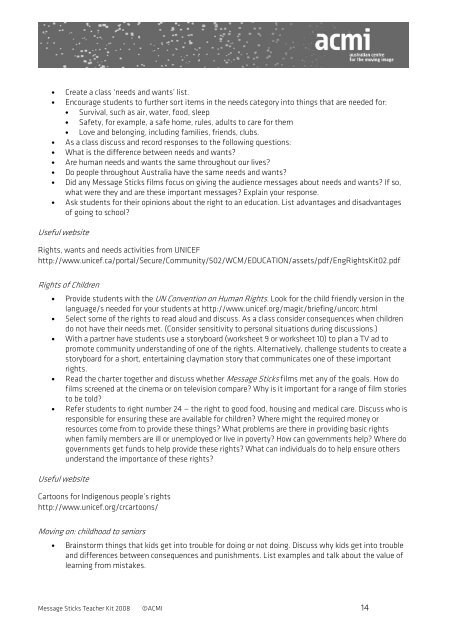July 2 â 3 - Sydney Opera House
July 2 â 3 - Sydney Opera House
July 2 â 3 - Sydney Opera House
You also want an ePaper? Increase the reach of your titles
YUMPU automatically turns print PDFs into web optimized ePapers that Google loves.
• Create a class ‘needs and wants’ list.<br />
• Encourage students to further sort items in the needs category into things that are needed for:<br />
• Survival, such as air, water, food, sleep<br />
• Safety, for example, a safe home, rules, adults to care for them<br />
• Love and belonging, including families, friends, clubs.<br />
• As a class discuss and record responses to the following questions:<br />
• What is the difference between needs and wants?<br />
• Are human needs and wants the same throughout our lives?<br />
• Do people throughout Australia have the same needs and wants?<br />
• Did any Message Sticks films focus on giving the audience messages about needs and wants? If so,<br />
what were they and are these important messages? Explain your response.<br />
• Ask students for their opinions about the right to an education. List advantages and disadvantages<br />
of going to school?<br />
Useful website<br />
Rights, wants and needs activities from UNICEF<br />
http://www.unicef.ca/portal/Secure/Community/502/WCM/EDUCATION/assets/pdf/EngRightsKit02.pdf<br />
Rights of Children<br />
• Provide students with the UN Convention on Human Rights. Look for the child friendly version in the<br />
language/s needed for your students at http://www.unicef.org/magic/briefing/uncorc.html<br />
• Select some of the rights to read aloud and discuss. As a class consider consequences when children<br />
do not have their needs met. (Consider sensitivity to personal situations during discussions.)<br />
• With a partner have students use a storyboard (worksheet 9 or worksheet 10) to plan a TV ad to<br />
promote community understanding of one of the rights. Alternatively, challenge students to create a<br />
storyboard for a short, entertaining claymation story that communicates one of these important<br />
rights.<br />
• Read the charter together and discuss whether Message Sticks films met any of the goals. How do<br />
films screened at the cinema or on television compare? Why is it important for a range of film stories<br />
to be told?<br />
• Refer students to right number 24 — the right to good food, housing and medical care. Discuss who is<br />
responsible for ensuring these are available for children? Where might the required money or<br />
resources come from to provide these things? What problems are there in providing basic rights<br />
when family members are ill or unemployed or live in poverty? How can governments help? Where do<br />
governments get funds to help provide these rights? What can individuals do to help ensure others<br />
understand the importance of these rights?<br />
Useful website<br />
Cartoons for Indigenous people’s rights<br />
http://www.unicef.org/crcartoons/<br />
Moving on: childhood to seniors<br />
• Brainstorm things that kids get into trouble for doing or not doing. Discuss why kids get into trouble<br />
and differences between consequences and punishments. List examples and talk about the value of<br />
learning from mistakes.<br />
Message Sticks Teacher Kit 2008 ©ACMI 14

















